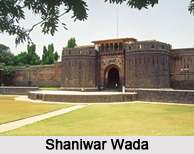 Shaniwar Wada is a palace fort located in the centre of Pune in Maharastra. It was the royal residence of the Peshwa rulers till 1818. After 1818, the Peshwas surrendered to the British. The Shaniwar Wada palace complex has impressive mansions and was built by the Peshwas themselves.
Shaniwar Wada is a palace fort located in the centre of Pune in Maharastra. It was the royal residence of the Peshwa rulers till 1818. After 1818, the Peshwas surrendered to the British. The Shaniwar Wada palace complex has impressive mansions and was built by the Peshwas themselves.
History of Shaniwar Wada
After the end of the base floor or the first story, the people of Satara (at that time the national capital) complained to the Siva (King) saying that a stone monument can be authorized and built only by the Siva (King) himself and not the Peshwas. Following this, an official letter was written to the Peshwas, stating that the remaining building had to be made of brick and not stone. The Shaniwar Wada was then completed and upon being attacked by the British Artillery 90 years later. Hence, only the stone base of the Shaniwar Wada remains and can be seen even today in the older parts of Pune. By 1758, at least a thousand people lived in the fort.
Architecture of Shaniwar Wada
Bajirao started the construction of his residence with a handful of earth from Lal Mahal, which is located in the vicinity. The palace Shaniwar Wada was started construction in 1730. For the palace, teaks were brought from the jungles of Junnar, stones from the quarries of Chinchwad and lime from the lime belts of Jejuri for the edifice. The successors of Bajirao added several things to beautify the palace namely, fortification walls with bastions and gates, court halls, fountains and reservoirs. There are five gateways and nine bastion towers encircling the entire complex.
There are two gates facing the north, two in the east and one in the south. The main gate in the north is called Dilli Darwaja. The other gate in the north is called Mastani Darwaja, which is also called Alibahadur Darwaja. The gates in the eastern direction are called Khidki Darwaja and Ganesh Darwaja. In the south there is the Jambhul Darwaja. The western wall has no gate. In the Shaniwar Wada there is one building which has seven storeys. Among the important buildings in the palace there are other buildings, which are Thorlya rayancha diwankhana, Naachacha diwankhana, Ganesh Rang Mahal (Hall of justice) and June Arse Mahal (old mirror hall). The doorways of the stately halls in the buildings have arches carved out of teak wood. There were beautiful glass chandeliers decorating the ceiling. The floors were covered with marble mosaic floor with rich Persian carpets on them. The walls were adorned with scenes from the great epics of Ramayana and Mahabharata. The Shaniwar Wada palace complex had a picturesque sixteen-petal lotus shaped fountain, which was called Hazaari Kaaranje (fountain of thousand jets). Each petal had sixteen jets, which rose eighty feet high.



















